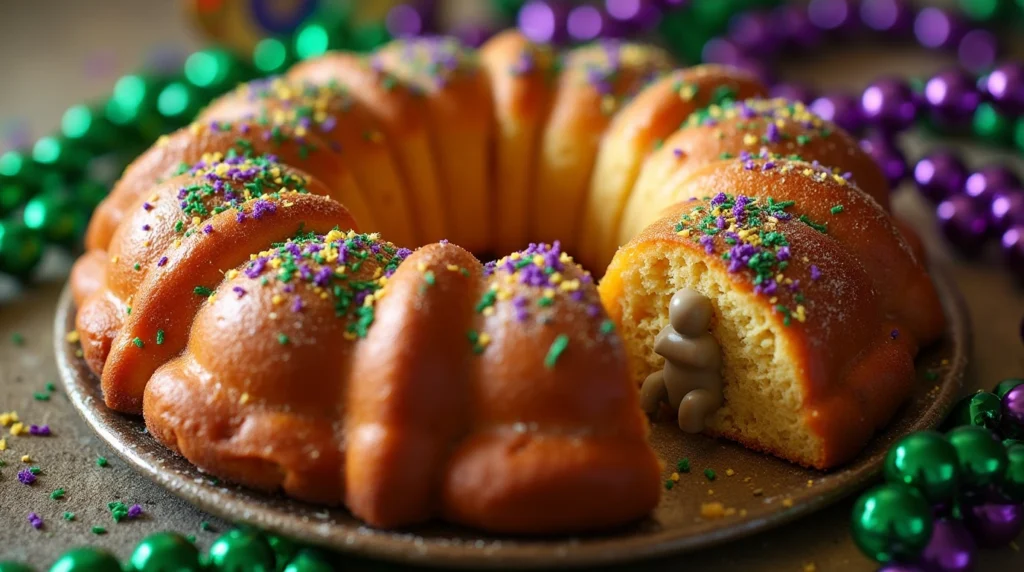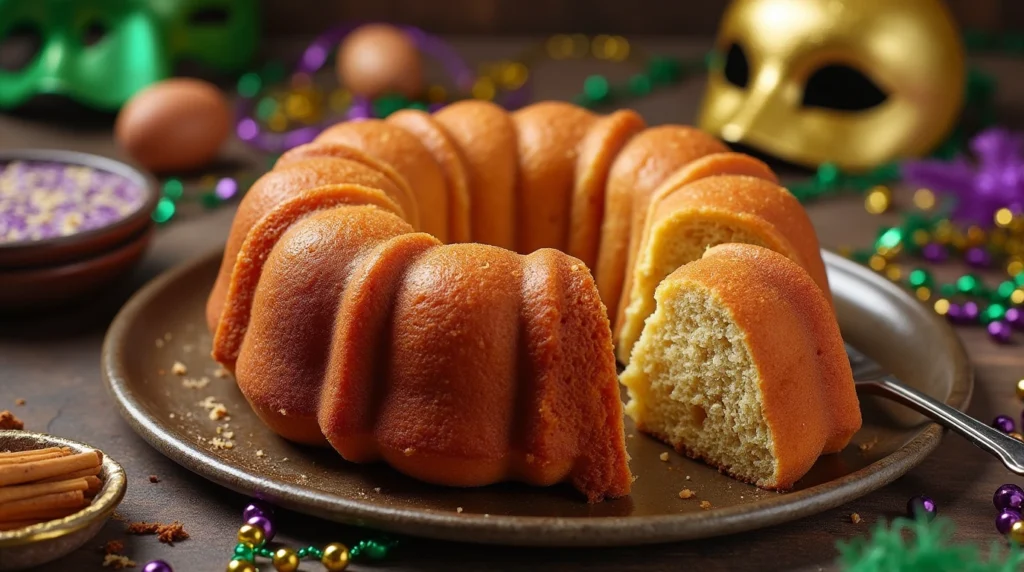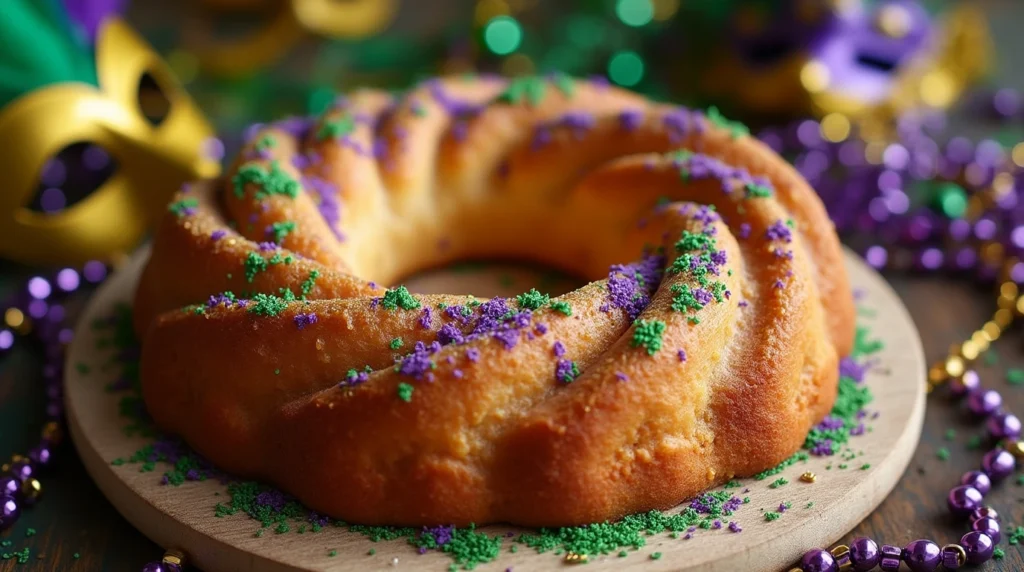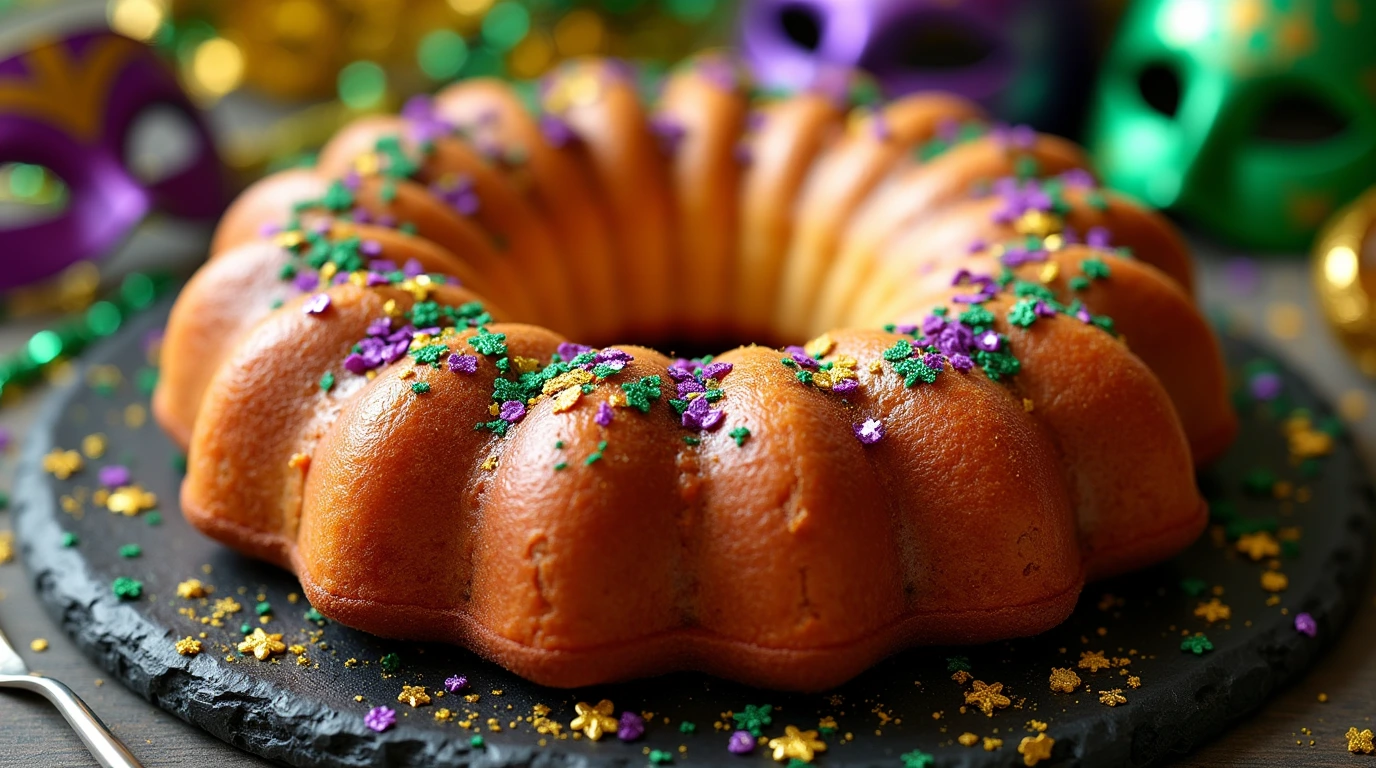If you’ve ever celebrated Mardi Gras or heard of its lively traditions, chances are you’ve come across a king cake. This festive and colorful dessert isn’t just a treat; it’s a symbol of joy, community, and tradition. With its sweet, cinnamon-infused dough, vibrant purple, green, and gold decorations, and the hidden baby figurine inside, king cake holds a special place in celebrations across the world, especially in Louisiana.
But here’s the best part: you don’t have to wait for Mardi Gras or visit a bakery to enjoy one. Making a king cake at home is easier than you might think, and it’s a fun way to bring a bit of that festive spirit into your kitchen. In this guide, I’ll show you how to make the perfect king cake from scratch, step by step. So, grab your apron, and let’s get started!
Table of Contents
What is King Cake and Why Is It So Special?

The History of King Cake
King cake has a rich and fascinating history that dates back centuries, with roots in European traditions. It all started with the celebration of Epiphany, also known as Three Kings’ Day, which falls on January 6th. This day commemorates the visit of the three wise men to baby Jesus, and the “king” in king cake refers to them. To honor this occasion, people would bake special cakes to symbolize the joy and significance of the day.
The tradition of king cake made its way to Louisiana in the 18th century, brought by French and Spanish settlers. Over time, it became deeply intertwined with Mardi Gras celebrations, growing into the iconic dessert we know today. In New Orleans, king cake season begins on Epiphany and lasts through Fat Tuesday, the day before Lent begins. During this time, you’ll find king cakes in nearly every bakery, home, and party, adding to the festive spirit of the season.
One of the most intriguing parts of king cake’s history is the tiny baby figurine hidden inside. Originally, this tradition symbolized baby Jesus, and finding the figurine in your slice was considered a blessing. Today, the person who finds the baby in their piece is often crowned “king” or “queen” of the party and is also tasked with hosting the next king cake celebration.
King cake has evolved over the years, with flavors and decorations changing to match modern tastes. While the classic version is filled with cinnamon and topped with colorful sugar, you can now find variations with cream cheese, fruit fillings, and even unique flavors like pecan praline. Despite these innovations, king cake remains a symbol of tradition, joy, and community.
By understanding its history, you’ll appreciate even more the significance of making and sharing this beloved dessert. It’s more than just a cake – it’s a way to connect with a centuries-old tradition and bring people together.
The Symbolism of King Cake
King cake isn’t just a delicious treat; it’s rich with meaning and symbolism that ties together centuries of tradition and celebration. Every part of the king cake, from its shape to its colors, carries a deeper significance, making it more than just a dessert.
The Ring Shape
One of the most striking features of a king cake is its shape—a large, circular or oval ring. This isn’t just for aesthetics; the ring shape is symbolic. It represents unity, eternity, and the never-ending nature of God’s love. In Christian tradition, it’s a nod to the circular journey of the three wise men as they searched for baby Jesus, guided by the Star of Bethlehem.
The Baby Figurine
Perhaps the most exciting part of a king cake is the tiny baby figurine hidden inside. Traditionally, this baby represents baby Jesus, tying the cake back to the celebration of Epiphany, when the wise men found Him. In modern times, the baby also adds an element of fun and surprise. Whoever finds the baby in their slice of cake is often declared the “king” or “queen” of the party. They’re celebrated for their “luck” and are typically given the honor (or responsibility!) of hosting the next king cake celebration.
The Colors of Mardi Gras
The vibrant purple, green, and gold colors that adorn a king cake are another layer of its symbolism. These are the official colors of Mardi Gras, and each one has a special meaning:
- Purple represents justice.
- Green symbolizes faith.
- Gold signifies power.
Together, these colors remind us of the spiritual and celebratory aspects of the season, blending joy with reflection.
Community and Sharing
Beyond its physical elements, king cake symbolizes community and togetherness. It’s designed to be shared, whether at family gatherings, office parties, or community events. The act of cutting and sharing the cake brings people together, fostering connection and celebration.
When you bake or enjoy a king cake, you’re participating in a tradition steeped in history and meaning. Every bite is a reminder of faith, joy, and the bonds that tie us to one another. It’s no wonder king cake remains such a cherished symbol of Mardi Gras and beyond.
How to Make the Perfect King Cake at Home

Ingredients You’ll Need
Making a king cake at home might seem intimidating at first, but it’s easier than you think once you have all the right ingredients. Each component plays an important role in creating the perfect combination of soft, sweet dough, flavorful filling, and colorful decoration. Here’s everything you’ll need to get started:
For the Dough
The dough is the foundation of your king cake, and it’s what gives it that signature soft and slightly sweet texture. Here’s what you’ll need:
- All-Purpose Flour: This is the base of your dough and gives it structure. You can also experiment with bread flour for a chewier texture.
- Active Dry Yeast: This is what makes the dough rise and gives it its fluffy texture. Be sure to check that your yeast is fresh for the best results.
- Granulated Sugar: Adds sweetness to the dough and helps feed the yeast during the rising process.
- Milk: Warm milk helps activate the yeast and creates a richer dough. Whole milk is ideal, but you can substitute with 2% or even a non-dairy option.
- Butter: Melted butter adds richness and flavor to the dough.
- Eggs: Eggs make the dough tender and help bind everything together.
- Salt: A pinch of salt enhances the flavor of the dough without making it salty.
For the Filling
The filling is where you can get creative and personalize your king cake. The most traditional option is a cinnamon-sugar mixture, but there are endless variations:
- Cinnamon and Brown Sugar: The classic filling that adds a warm, sweet flavor to your cake.
- Cream Cheese: For a rich and creamy filling that pairs perfectly with the sweet dough.
- Fruit Preserves: Options like raspberry, strawberry, or apricot add a fruity twist.
- Pecan Praline: A Southern favorite that combines chopped pecans, brown sugar, and butter for a nutty, caramel-like filling.
For the Glaze and Decorations
No king cake is complete without its vibrant decorations. Here’s what you’ll need to make it shine:
- Powdered Sugar: The base of the glaze that adds sweetness and creates a smooth finish.
- Milk or Water: To thin out the glaze to your desired consistency.
- Vanilla Extract: Adds a hint of flavor to the glaze.
- Purple, Green, and Gold Colored Sugar: These iconic colors represent Mardi Gras and add a festive flair. You can make your own by mixing granulated sugar with food coloring if needed.
Optional Extras
- Plastic Baby Figurine: Hiding this in your cake is part of the tradition, but make sure to tell your guests to watch out for it!
- Food Coloring: To tint your glaze if you want extra vibrant colors.
Having all your ingredients ready and measured before you start will make the process much smoother. With these items in hand, you’re well on your way to creating a king cake that’s as beautiful as it is delicious. Let’s move on to the fun part—putting it all together!
Step-by-Step Instructions
Making a king cake at home is a fun and rewarding experience. While it might seem like a big project, breaking it down into simple steps makes it totally manageable. Follow this guide to create a beautiful and delicious king cake from scratch!
Step 1: Prepare the Dough
The dough is the heart of your king cake, so take your time to get it just right.
- Activate the Yeast
- Warm your milk to about 110°F (not too hot, or it’ll kill the yeast).
- Stir in a tablespoon of sugar and sprinkle the yeast on top. Let it sit for 5-10 minutes until it’s foamy. This step ensures your yeast is active and ready to work.
- Mix the Dough
- In a large mixing bowl, combine the flour, sugar, and salt.
- Add the yeast mixture, melted butter, and eggs. Stir until the dough starts to come together.
- Knead the Dough
- Turn the dough out onto a floured surface and knead for 8-10 minutes, or until it’s smooth and elastic. Alternatively, you can use a stand mixer with a dough hook.
- Let It Rise
- Place the dough in a greased bowl, cover it with a clean kitchen towel, and let it rise in a warm spot for 1-2 hours, or until it doubles in size.
Step 2: Assemble the Cake
Once your dough has risen, it’s time to shape and fill your king cake!
- Roll Out the Dough
- Punch down the dough and roll it into a large rectangle, about ¼-inch thick.
- Add the Filling
- Spread your chosen filling (e.g., cinnamon sugar, cream cheese, or fruit preserves) evenly over the dough, leaving a small border around the edges.
- Shape the Cake
- Roll the dough tightly into a log, starting from the long side.
- Pinch the edges to seal, then gently form the log into a ring shape. Transfer it to a baking sheet lined with parchment paper.
- Hide the Baby
- If you’re using a plastic baby figurine, tuck it into the dough now or after baking if you prefer to avoid melting.
- Second Rise
- Cover the shaped dough with a towel and let it rise again for 30-45 minutes, until it’s slightly puffed.
Step 3: Bake and Decorate
Now for the final steps to bring your king cake to life!
- Bake the Cake
- Preheat your oven to 350°F (175°C).
- Bake the king cake for 25-30 minutes, or until it’s golden brown and cooked through. Let it cool completely before decorating.
- Make the Glaze
- In a bowl, mix powdered sugar, milk (or water), and vanilla extract until you get a smooth, pourable consistency.
- Decorate with Mardi Gras Colors
- Drizzle the glaze over the cooled cake.
- Sprinkle the purple, green, and gold sugar over the glaze in sections to create a festive look.
Step 4: Serve and Enjoy
Your homemade king cake is ready to wow your family and friends! Slice it up and serve, but don’t forget to warn everyone about the hidden baby. Whoever finds it gets to host the next celebration!
By following these steps, you’ll create a king cake that’s not just a dessert but a celebration in itself. Enjoy the process, and don’t be afraid to put your own creative spin on it!
Tips for Success
Making a king cake at home can be a rewarding experience, and with a few helpful tips, you can ensure your cake turns out perfect every time. Here are some easy-to-follow pointers to help you along the way:

1. Use Fresh Ingredients
- Check Your Yeast: Yeast is the key to a fluffy and airy dough. Make sure your yeast is fresh and active by testing it in warm milk or water before adding it to the dough. If it doesn’t foam, it’s time to get a new packet.
- High-Quality Ingredients: Use fresh eggs, good-quality butter, and flavorful fillings to elevate the taste of your king cake.
2. Give the Dough Time to Rise
- Be Patient: Allow the dough to rise fully during both the first and second rises. A warm, draft-free spot in your kitchen is ideal. If your dough isn’t rising, check that your yeast was properly activated and that the environment is warm enough (but not too hot).
- Don’t Rush: The rising process is crucial for achieving a light and tender texture, so plan your time accordingly.
3. Roll and Shape Carefully
- Even Thickness: When rolling out the dough, aim for an even thickness to ensure the cake bakes uniformly.
- Seal the Edges: After rolling up the dough with the filling, make sure to pinch the seams tightly. This prevents the filling from leaking out during baking.
- Shape with Care: Gently form the dough into a ring without pulling or overstretching it. This keeps the cake intact and helps it hold its shape.
4. Get Creative with Fillings and Decorations
- Try New Fillings: While cinnamon sugar is a classic, don’t be afraid to experiment with other flavors like cream cheese, fruit preserves, chocolate, or even pecan praline.
- Vibrant Decorations: Use vibrant purple, green, and gold sugar to make your cake look festive. If you don’t have colored sugar, you can make your own by mixing granulated sugar with a few drops of food coloring.
5. Bake with Precision
- Monitor Baking Time: Keep an eye on your cake as it bakes to avoid overcooking. The edges should be golden brown, and the center should be cooked through.
- Cool Completely: Let the cake cool completely before adding the glaze and sugar decorations. This prevents the glaze from melting and ensures a polished finish.
6. Safety First with the Baby Figurine
- Choose the Right Spot: If you’re adding the baby figurine before baking, make sure it’s oven-safe. Alternatively, you can insert it into the baked cake for easier placement.
- Warn Your Guests: Let everyone know about the hidden baby to avoid any surprises (or accidental bites!).
7. Store and Serve Properly
- Keep It Fresh: If you’re not serving the cake immediately, store it in an airtight container at room temperature for up to 2 days or refrigerate it for longer storage.
- Reheat Gently: If needed, warm individual slices in the microwave for a few seconds to bring back that fresh-baked taste.
8. Embrace the Fun
- Involve the Family: Making a king cake is a fun activity to share with family and friends. Get kids involved in decorating or hiding the baby figurine.
- Enjoy the Tradition: Remember that king cake is about celebration and community. Even if it’s not perfect, it’s the love and effort that makes it special.
By keeping these tips in mind, you’ll set yourself up for success and create a king cake that’s as delightful to look at as it is to eat. Enjoy the process, and happy baking!
Conclusion
Making a king cake at home is more than just baking; it’s about embracing a tradition that’s rich in history, meaning, and community. From mixing the dough to sprinkling the final touches of colorful sugar, every step brings you closer to creating something special that you can share with family and friends.
King cake is more than a dessert. It’s a celebration—a symbol of joy, togetherness, and the festive spirit of Mardi Gras. By making one yourself, you’re not just recreating a timeless tradition but also adding your own personal touch to it. Whether it’s the classic cinnamon filling, a creamy twist, or a burst of fruity flavor, your king cake will reflect your creativity and love.
Don’t worry if it doesn’t turn out bakery-perfect. The beauty of homemade king cake lies in its imperfections—it’s the effort, the laughter, and the shared moments that make it truly perfect. And when someone finds the hidden baby figurine in their slice, you’ll have added an extra layer of fun and anticipation to the celebration.
So, as you finish baking and decorating your king cake, take a moment to appreciate what you’ve created. Enjoy the smiles and excitement it brings to your table. And remember, the tradition doesn’t end here—it continues with the next celebration, the next cake, and the next group of people gathered to enjoy it together.
Happy baking, and may your king cake be the centerpiece of a memorable celebration!

